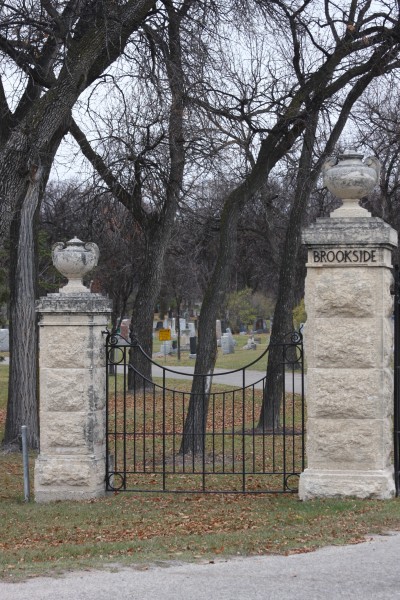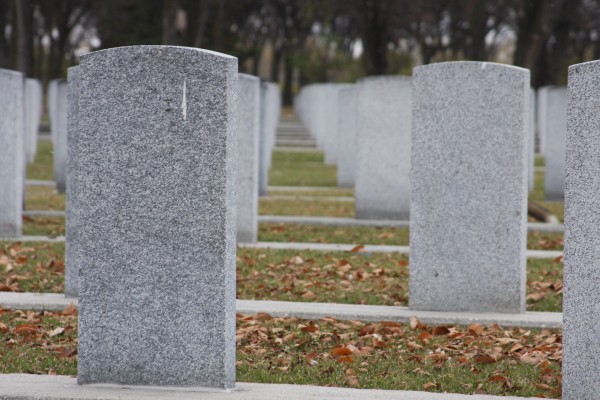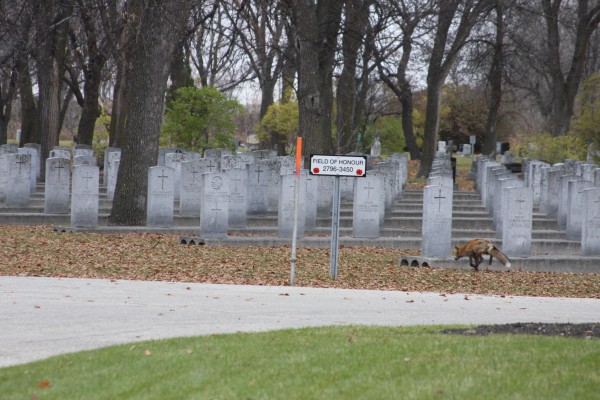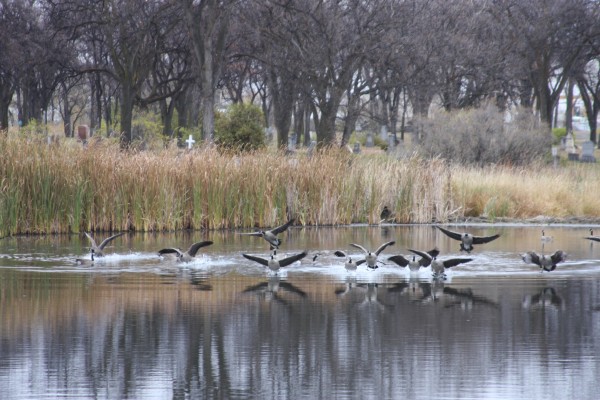Just over the creek is where it all began roughly 135 years ago. Standing over a sea of some 11,000 chalky white clonal tombstones in uniform rows, the indistinct buzzes and hums from the adjacent airport and industrial park permeate and corrupt an otherwise serene autumn cemetery scene. Geese are dabbling and landing on the creek’s calm surface waters; a great grey owl can be faintly heard, hooting from the canopy of a gnarled, knotted, nearby ash tree in the semidarkness of dusk; and a lone red fox nonchalantly hops and weaves through those very same rows, directionless, as snow begins to fall and melt, dampening its thick coat.
It is a rare day indeed when we consider a visit to the cemetery in search of a good time; whether to learn something about its permanent residents – dead or otherwise; or how the place factors into the greater history of our city. Enter: Brookside Cemetery.
Located at 3001 Notre Dame Avenue, west of Red River College and Route 90, Brookside is one of the City’s most history-rich cemeteries, and has a distinct park-like feel with some of the best wildlife viewing opportunities on offer locally. It is the largest cemetery in Western Canada and employs the majority of the City of Winnipeg’s municipal cemeteries’ branch staff.
The buried famous
In terms of notable grave sites, major Harry Colebourn—who donated the black bear “Winnipeg” or “Winnie” to a London zoo in World War I, later inspiring the book Winnie-the-Pooh—is buried at Brookside, as is Sgt. Tommy Prince (Manitoba’s most decorated Aboriginal veteran), as well as northender and NHL great, Billy Mosienko, famously known for scoring three goals in under 21-seconds.
Brookside is also the final resting place for 24 of the 31 casualties of the Dugald train disaster of 1947.
“One of the most devastating train wrecks in Canadian history [ . . . ] Only seven of the victims could be identified and the remaining 24 were buried in a mass grave at the Brookside Cemetery,” states the Manitoba Historical Society’s website.
Historically speaking
Brookside has been owned and operated by the City of Winnipeg since 1878. “The first burial that we have on record is just recorded as the infant son of George Smith,” said Jane Saxby, cemeteries administrator at the City of Winnipeg.
Moving ahead to 1915, a military field of honour was erected at Brookside, now considered by some to be the most significantly designed Field of Honour in Canada. There are over 11,000 internments marked with upright military monuments mounted on beams.
All markers in the field of honour face east, save for the teardrop section, which contains approximately 150 of the very first monuments of the field, as well as the Stone of Remembrance – the only commonwealth war graves commissioned stone of its kind in Canada. “[The Stone of Remembrance] is here to mark the high number of commonwealth war dead that are here,” said Saxby.
Manitoba had the highest number of volunteer war recruits in Canada during the first and second World Wars, many of whom returned only to succumb to illnesses or injuries sustained while at war, said Saxby.
Not to fear
“The one thing I would say to people, because it is coming up to Halloween, is that the cemetery is not a place full of the dead – the cemetery is a living place,” Saxby told the Manitoban.
On top of the wildlife species previously mentioned, Brookside is seasonally home to mating pairs of great horned owls, ducks, squirrels, skunks, raccoons, deer, many migratory songbird species, and even otters and beavers on occasion.
“Last year we had something like 14 beavers in the creek. [We had to get trappers in to take them away] because the trees were vanishing,” said Saxby. “I can’t express this to people enough: [ . . . ] this isn’t a place to fear, this is a place to come and sit and enjoy the geese and ducks on the creek.”
The City of Winnipeg is offering guided tours of the Field of Honour to the public as well as to schools from Nov. 4 to Nov. 8. For more details, call 311 or visit and click the “Remembrance week tours” icon at http://www.winnipeg.ca/interhom/









